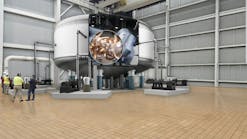Canada taking stake in Westinghouse eVinci Nuclear Micro-Reactor as Carbon-free option for Industrial and Remote regions
The Canadian government is investing C$27.2 million ($19M U.S.) in Westinghouse’s portable and nuclear micro reactor which could bring off-grid power to industrial sites, data centers, universities and other mission-critical energy customers in the country.
Westinghouse has been developing its eVinci micro-reactor with the idea of use at remote sites and military bases or other users which may need to disconnect from the main grid. Nuclear power generation is considered carbon free in terms of emissions.
In Canada, the nation’s grid already utilizes a relatively high volume of conventional nuclear power. Leaders are enthusiastic about the Westinghouse eVinci’s potential for helping fight climate change.
“As our government moves swiftly with our green economic recovery, we are laying the foundation for a better-prepared and more prosperous climate-oriented future,” Francois-Philippe Champagne, Minister of Innovation, Science and Industry, said in a statement. “Westinghouse’s innovative technology will help deliver clean energy sources across Canada, especially in remote communities.
Westinghouse has worked on version of small nuclear reactors for decades. The company hopes to test its eVinci in a demonstration project by 2023 and deploy commercially by 2025.
The eVinci is designed to generate combined heat and power (CHP) by a capacity of up to 5 MW electricity and 13 MW thermal. It is planned to be fully factory built and assembled, with fueling stages lasting eight years before the next refueling, according to the company.
"The eVinci micro-reactor technology enables many applications which will benefit Canadian industries and communities, especially those in need of carbon-free heat and power," said David Durham, President, Westinghouse Energy Systems. "We appreciate the Government of Canada’s partnership and are proud to support a Pan-Canadian energy transition program in support of net-zero emissions targets."
The design combines the Los Alamos National Laboratory’s heat pipe technology and Westinghouse's commercial reactor design and manufacturing. The alkali metal pipe technology is purported to offer simpler but safer plant operation.
In addition to the electricity, Westinghouse says, the high level heat can be utilized in industrial applications including hydrogen generation and desalination, among others.
Related stories
Small Modular Reactors: Is Micro Nuclear an option for Net Zero Microgrids?
U.S. DOE awards $8.5M to Next-gen Nuclear Demonstration Projects
Arizona to demo Hydrogen generation from Nuclear Energy
Subscribe to EnergyTech's free Newsletter for More Insights into the C&I Energy Transition
Proponents of a greater role for nuclear in the push to reduce carbon emissions from the energy sector include former Energy Sec. Ernest Moniz, Microsoft co-founder Bill Gates, ecologist Thomas Lovejoy and physicist Wade Allison, among many others. Some believe there is no path to Net Zero without a greater role for nuclear energy.
Supporters tout SMR nuclear for smaller footprints, passive safety systems and lower cost of installation compared with massive projects such as Southern Co.'s Vogtle expansion in Georgia. They also point to its ability to generate baseload power.
Detractors say nuclear installation of any size is still too costly and uncertain compared to wind, solar and energy storage. Also, it's noted that no SMR nuclear plant is currently in operation.
- - -
(Rod Walton has spent 14 years covering the energy industry as a newspaper and trade journalist. He formerly was energy writer and business editor at the Tulsa World. Later, he spent six years covering the electricity power sector for Pennwell and Clarion Events. He joined Endeavor and EnergyTech in November 2021).





